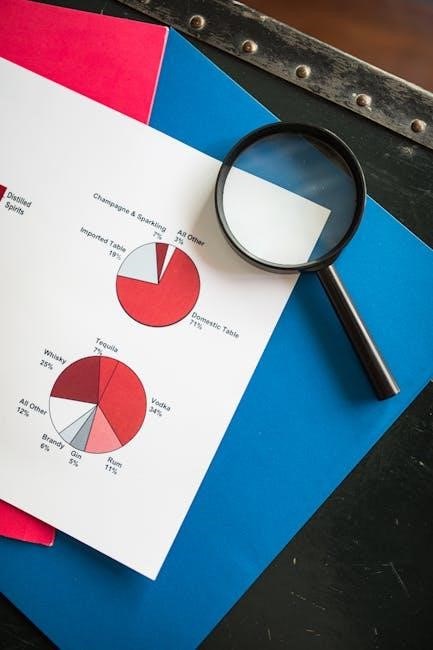statistics project examples pdf
Statistics Project Examples PDF: A Comprehensive Guide
This comprehensive guide explores the realm of statistics project examples available in PDF format. It offers valuable insights into conducting statistical analysis, interpreting results, and presenting findings concisely. These PDFs serve as essential resources for students, providing practical guidance and inspiration.
Statistics projects offer a unique opportunity to apply theoretical knowledge to real-world scenarios. These projects involve collecting, analyzing, and interpreting data to draw meaningful conclusions. Students often find themselves challenged but also greatly rewarded by the practical experience gained. Such projects often involve hypothesis testing, data visualization, and statistical modeling, reinforcing key concepts learned in the classroom.
Undertaking a statistics project encourages critical thinking and problem-solving skills, essential for success in various fields. The process typically involves defining a research question, selecting appropriate statistical methods, and presenting findings in a clear and concise manner. Successfully completing a statistics project demonstrates a student’s ability to apply statistical principles to solve real-world problems, a valuable asset in today’s data-driven world.

Understanding the Purpose of Statistics Projects
Statistics projects serve to bridge theoretical knowledge with practical application. They allow students to explore real-world problems, analyze data, and draw meaningful conclusions, enhancing their analytical and problem-solving skills.
Applying Statistical Analysis
Applying statistical analysis is a crucial step in any statistics project. It involves selecting appropriate statistical methods to analyze collected data and test formulated hypotheses. The choice of method depends on the type of data, research question, and desired level of inference. Common statistical techniques include regression analysis, t-tests, ANOVA, and chi-square tests. These methods help to identify relationships between variables, compare group means, and assess the statistical significance of findings.
Furthermore, careful consideration must be given to assumptions underlying each statistical test to ensure validity and reliability of results. Proper application of statistical analysis provides valuable insights and supports evidence-based decision-making.

Key Components of a Statistics Project
A statistics project involves data collection, hypothesis testing, and data interpretation. These elements are essential for conducting meaningful research and drawing valid conclusions. Careful planning ensures a successful statistical endeavor.
Data Collection Methods
Effective data collection is crucial for any statistics project, influencing the validity and reliability of findings. Surveys, experiments, and observations are common approaches. Surveys gather information through questionnaires, while experiments manipulate variables to establish cause-and-effect relationships. Observational studies involve collecting data without intervention.
Choosing the appropriate method depends on the research question and available resources. Surveys are suitable for gathering opinions or attitudes, while experiments are ideal for testing hypotheses. Observational studies are useful for exploring phenomena in natural settings. Each method requires careful planning and execution to minimize bias and ensure data accuracy. Proper sampling techniques are important for representing the population.
Hypothesis Testing
Hypothesis testing is a core component of statistical analysis, enabling researchers to evaluate claims about populations. It involves formulating a null hypothesis (a statement of no effect) and an alternative hypothesis (a statement of an effect). Data is then collected and analyzed to determine whether there is sufficient evidence to reject the null hypothesis.
Common hypothesis tests include t-tests, chi-square tests, and ANOVA. The choice of test depends on the type of data and the research question. The significance level (alpha) determines the threshold for rejecting the null hypothesis. A p-value less than alpha indicates statistically significant evidence against the null hypothesis. Careful interpretation of results is important to avoid drawing incorrect conclusions.
Data Interpretation and Presentation
Data interpretation involves drawing meaningful conclusions from statistical analysis. This requires understanding the context of the data, the limitations of the analysis, and the implications of the findings. It’s crucial to avoid overstating results and to acknowledge potential biases. Effective communication is essential for conveying the story the data tells.
Data presentation is the art of visually representing data to facilitate understanding. Common methods include tables, charts, and graphs. Charts and graphs should be clear, concise, and accurately reflect the data. Tables are useful for presenting detailed numerical information. Choosing the appropriate presentation method depends on the type of data and the message being conveyed. Proper labeling and scaling are necessary for accurate interpretation.

Statistics Project Ideas and Examples
This section delves into specific statistics project ideas and provides concrete examples to inspire students. Each example illustrates the application of statistical methods to real-world scenarios, fostering creativity and practical understanding.
Cell Phone Usage Analysis
Embark on a statistics project centered around cell phone usage, a topic deeply ingrained in modern life. This engaging project requires students to gather relevant data pertaining to cell phone habits. Students will be asked to analyze (Five Number Summary) and display the data in a myriad of formats (Frequency Histograms, Box-and-Whisker plots, Stem and Leaf plots, etc).
The project involves collecting data on various aspects of cell phone use, such as time spent, apps used, and communication patterns. Statistical analysis can reveal trends, correlations, and potential impacts of cell phone use on individuals and society.
Consider exploring the relationship between cell phone usage and academic performance, social interaction, or mental well-being; Students will analyze and organize data, summarize it, and describe it the way it is explained in Chapter 1.
Hypothesis Testing Project Examples
Explore the world of hypothesis testing through practical project examples that demonstrate real-world inferential statistics. Begin by taking a claim, forming a hypothesis from that claim, and then collecting data to test the hypothesis. Perform a hypothesis test and interpret the results.
Consider investigating whether the average cost of tuition is lower than the average stated by The University of Idaho. Utilize the T-test for a mean, since the sample size is less than 30 and the population standard deviation is unknown.
Another example could be to hypothesize why men or women study more. Collect and analyze data to test your hypotheses. The statistical analysis methods could include the T-test, Z-test, F-test and Chi-square test.

Resources for Statistics Projects
Discover valuable resources to aid in your statistics projects, including PDF examples and templates. Explore statistical software and tools to enhance your data analysis and presentation skills, ensuring project success.
PDF Examples and Templates
This section provides a curated collection of statistics project examples available in PDF format. These examples illustrate how to conduct a statistical analysis, interpret results, and present findings in a clear and concise manner. These PDFs serve as valuable guides for students seeking inspiration and practical guidance.
Explore diverse project types, ranging from hypothesis testing to data visualization, all accessible in a convenient PDF format. Leverage these templates to structure your projects effectively, ensuring adherence to statistical principles.
The examples cover various statistical methods, including regression analysis, ANOVA, and chi-square tests. Use these resources to enhance your understanding and elevate the quality of your work.
Statistical Software and Tools
Navigating the world of statistical analysis requires the right software and tools. Several options cater to different skill levels and project requirements. Popular choices include SPSS, known for its user-friendly interface and comprehensive features, and R, a powerful open-source environment for statistical computing and graphics.
Excel, with its built-in statistical functions, can be suitable for simpler projects. For advanced modeling and simulation, consider using specialized software like SAS or MATLAB. Online platforms like StatCrunch provide collaborative analysis and data visualization capabilities.
Selecting the appropriate tool depends on the project’s complexity, data size, and desired level of customization. Ensure compatibility with your project’s data formats and analysis methods.
Writing a Statistics Project Proposal
Crafting a strong statistics project proposal is crucial for approval. Key elements include a clear research question, population/sample description, and outlined statistical methods. A well-defined proposal sets the stage for successful research.
Defining the Research Question
The cornerstone of any successful statistics project lies in a clearly defined research question. This question serves as the guiding light for your entire investigation, dictating the data you collect, the analyses you perform, and the conclusions you draw. A well-formulated research question should be specific, measurable, achievable, relevant, and time-bound (SMART).
Start by identifying a broad area of interest within statistics. Consider real-world problems or phenomena that pique your curiosity. Next, narrow down your focus to a specific aspect of that area. Brainstorm potential questions that you could investigate using statistical methods.
Critically evaluate each potential question. Is it too broad or too narrow? Is it feasible to collect the necessary data? Is it relevant to the field of statistics? Revise and refine your question until it meets the SMART criteria.
A strong research question will provide a clear direction for your statistics project and ensure that your efforts are focused and productive.
Describing the Population and Sample
In statistical research, clearly defining the population and selecting an appropriate sample are crucial steps. The population refers to the entire group you’re interested in studying, possessing specific characteristics. A well-defined population is essential for establishing the scope of your findings and ensuring their generalizability.
Due to practical constraints, it’s often impossible to study the entire population. Instead, a sample – a subset of the population – is selected for analysis. The sample should be representative of the population to ensure that the results obtained from the sample can be accurately generalized back to the population.
When describing the population, provide detailed information about its characteristics, such as demographics, location, and relevant traits. For the sample, explain the sampling method used (e.g., random sampling, stratified sampling), the sample size, and any potential biases that may have been introduced during the sampling process.
A thorough description of the population and sample is vital for assessing the validity and reliability of your statistical project.
Outlining Statistical Analysis Methods
A crucial component of any statistics project proposal is a clear and concise outline of the statistical analysis methods that will be employed. This section demonstrates your understanding of the appropriate techniques for addressing the research question and testing the hypotheses.
Begin by identifying the specific statistical tests that will be used, such as t-tests, ANOVA, regression analysis, or chi-square tests. Justify the selection of each test by explaining how it aligns with the type of data being analyzed and the nature of the research question.
Detail the steps involved in each statistical analysis, including data preparation, assumptions checking, and interpretation of results. Specify the software or tools that will be used for data analysis, such as SPSS, R, or Excel.
Clearly outlining the statistical analysis methods provides a roadmap for the project and demonstrates your competence in applying statistical techniques to answer the research question. This section ensures that the analysis is rigorous, transparent, and reproducible.

